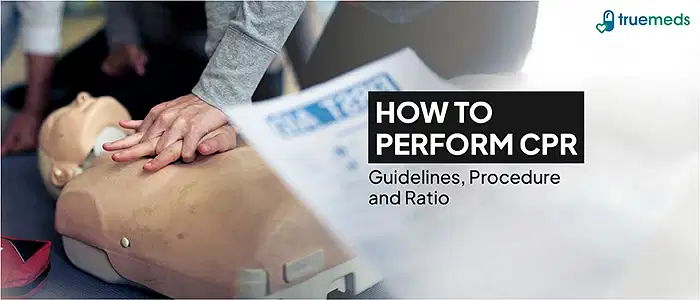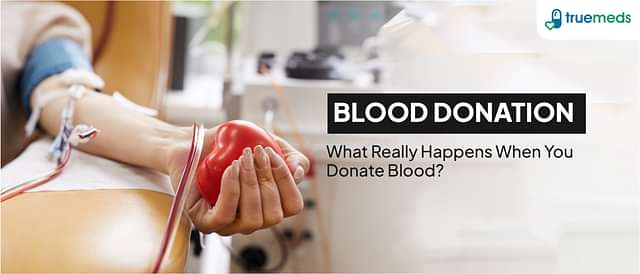How to Perform CPR: Guidelines, Procedure, and Ratio
Last updated on : 26 Sep, 2024
Read time : 9 min
Introduction
CPR, or Cardiopulmonary Resuscitation, is a crucial emergency procedure used during cardiac arrest or when someone stops breathing. This lifesaving technique aims to maintain blood flow and oxygenation to vital organs, particularly the brain and heart. It continues until normal heart function is restored or medical help arrives.
Understanding the correct CPR steps and ratios is essential for anyone who may need to assist in a medical emergency. This skill is crucial for both non-medical individuals and healthcare professionals. In this article, we will explore the detailed process of performing CPR correctly and efficiently.
Introduction of CPR
CPR is essential in cases of cardiac arrest, also it plays a pivotal role during incidents like drowning or choking. Here, immediate intervention can drastically improve the chances of survival. The CPR process involves a mix of chest compressions and rescue breaths. This collectively works to circulate blood and provide oxygen to the body.
The effectiveness of CPR depends significantly on adhering to guidelines, such as the compression-to-ventilation ratio, which for adults is 30:2. This ratio specifies that the rescuer should administer 30 chest compressions followed by 2 rescue breaths. By doing so, circulation is maintained and oxygen provision is optimised during a cardiac emergency. This is crucial in improving survival rates and reducing the risk of organ damage.
What Is CPR in Medical Terms?
CPR is performed when a person’s heart stops beating, a condition medically referred to as cardiac arrest. The main purpose of CPR is to maintain blood circulation and oxygen supply to the vital body organs. In essence, CPR acts as a bridge until professional medical help arrives.
The CPR method involves two main steps.
- First, chest compressions are given to maintain blood flow.
- These are followed by rescue breaths (also known as mouth-to-mouth resuscitation), which ensure the continued supply of oxygen.
Knowing how to perform CPR is crucial. It can be the difference between life and death before a doctor or paramedic can provide definitive care.
What Is the Most Critical Component of CPR?
High-quality chest compressions stand out as the critical component in the CPR procedure. Here are five key reasons that emphasise their critical importance:
- Chest compressions help keep blood flowing through the heart and onto vital organs like the brain.
- They should be done at an adequate rate of at least 100-120 compressions per minute.
- The compressions’ depth also matters; they should be about 5-6 cm deep for adults.
- It’s essential not to lean on the victim between compressions, as this can interfere with blood flow.
- Proper hand placement on the centre of the chest ensures effective compression.
These steps are vital in giving someone the best chance for survival after cardiac arrest. Over-ventilation or excessive breaths should be avoided as they can decrease the effectiveness of chest compressions.
CPR Procedure: Step-by-Step
Performing CPR involves a series of steps that should be followed promptly and effectively. Here’s a step-by-step guide:
- Check the scene for safety: Make sure it is safe for you and the victim. It’s crucial not to put yourself in danger while trying to save someone else.
- Assess responsiveness: Gently tap the person and shout to see if they respond. If there is no response, call emergency services immediately or ask someone nearby to do so.
- Position the person: Lay them flat on their back on a solid, flat surface. This position helps facilitate effective chest compressions.
- Open the airway: Applying the head-tilt/chin-lift method, you can ensure that the person’s airway is open and unblocked.
- Check for breathing: Listen carefully and feel for any signs of breathing for no more than 10 seconds. If there’s no breathing or gasping, you need to start CPR immediately.
- Perform chest compressions:
- Place the heel of one hand on the centre of the chest, just below the nipples. Place your other hand on top and interlock your fingers.
- Keep your arms straight and use your body weight to compress the chest at least 2 inches deep at a rate of 100 to 120 compressions per minute.
- Allow the chest to fully recoil between compressions.
- Give rescue breaths:
- After 30 compressions, give 2 rescue breaths.
- Pinch their nose shut. Take a normal breath, seal your lips over theirs, and blow for 1 second, watching for the chest to rise. Repeat for the second breath.
- Continue the cycle: Keep repeating this sequence of 30 compressions followed by 2 rescue breaths. Continue this CPR procedure until medical help arrives or signs of life are evident.
- Use an AED if available: An Automated External Defibrillator (AED) can be exceedingly helpful in reviving a person whose heart has stopped. Use it as per the device’s instructions.
How to Perform CPR on a Child?
CPR for a child differs slightly from an adult due to their smaller size and differing anatomy. This is how to give CPR to a child:
- Check the scene for safety: It’s critical to ensure safety first before you proceed.
- Assess responsiveness: Gently tap and shout at the child to ascertain if they’re responsive. If not, call for help.
- Position the child: Lay the child flat on their back on a firm surface.
- Open the airway: Use the head-tilt/chin-lift method to open the child’s airway.
- Check for breathing: Spend up to 10 seconds checking for normal breathing. If no breaths or only gasps are detected, start CPR immediately.
- Perform chest compressions: Using only one hand, place it in the centre of the chest, between the nipples, and deliver chest compressions.
- Give rescue breaths: After 30 compressions, give 2 rescue breaths. Ensure the chest rises with each breath by watching closely.
- Continue the cycle: Keep repeating this sequence of 30 compressions and 2 rescue breaths until medical help arrives or signs of life are evident.
- Use an AED if available: If available, use an AED as soon as possible, following the device’s instructions.
CPR for children is vital, as prompt action can significantly increase the chances of survival in emergencies.
When to Perform CPR and When Not To?
CPR is a life-saving procedure, which is performed when a person’s heartbeat or breathing has stopped. However, it’s crucial to know when it’s appropriate to perform CPR and when it isn’t.
When to Perform CPR?
Performing CPR isn’t limited to medical professionals; anyone can do it and potentially save a life. However, you should only perform it under the following circumstances:
- Unconsciousness: If a person is unconscious and unresponsive, start the CPR process immediately.
- Cardiac arrest: This is the most common scenario for CPR. If the heart stops beating effectively, the person will cease to breathe and lose consciousness.
- Choking: In severe choking cases where the individual becomes unconscious, CPR steps maintain blood flow and oxygenation.
- Electrocution: If someone is electrocuted and becomes unresponsive, start the CPR process immediately after ensuring safety.
- Drowning: After rescuing someone from the water, if they are unresponsive and not breathing, initiate the CPR procedure.
- Drug Overdose: If a person is unresponsive due to a drug overdose, especially opioids, and isn’t breathing, performing CPR is critical.
- Suffocation: If someone is found unconscious due to suffocation, CPR is required if they are not breathing or do not have a pulse.
| How can I get certified in CPR in India?To get certified in CPR in India, you can choose from various organizations that offer training courses, both online and in-person. Here are some notable options:First Aid & CPR InstituteIndian Red Cross SocietySave Life FoundationEnsure to choose a certified provider that meets your needs and offers recognized certification. |
When Not to Perform CPR?
However, there are situations where performing CPR isn’t necessary or safe:
- The person is breathing normally: If the individual is breathing normally, there’s no need for CPR.
- The scene is unsafe: If the environment poses a danger to you or the victim (e.g., fire, traffic), do not attempt CPR until it is safe.
- The person is responsive: If the individual regains consciousness and begins to breathe normally, you should stop CPR.
- You are exhausted: CPR can be physically demanding. If you feel too fatigued to continue effective compressions, it is advisable to swap with another rescuer if available.
When to Seek Emergency Help?
While CPR is important, immediate professional medical help is necessary in the following situations:
- Severe bleeding: If someone is bleeding profusely and it isn’t stopping with direct pressure, seek help immediately.
- Difficulty in breathing: If someone is struggling to breathe or has stopped breathing, it’s time to call in the professionals.
- Unconsciousness: If a person is unresponsive or cannot be awakened, call for help without delay.
- Severe burns: Burns that cover a large part of the body or are deep need immediate attention from healthcare professionals.
- Serious accidents or trauma: Any significant injury that could result in complications requires immediate medical assistance.
Frequently asked questions (FAQs)
Both of these procedures are life-saving methods. CPR procedure includes chest compressions and breaths, while mouth-to-mouth resuscitation involves only breathing into the patient’s mouth.
The CPR steps involve 30 chest compressions, followed by two rescue breaths. This pattern is recommended for adults, children, and infants.
In adults, the depth of chest compressions during the CPR process should be at least 5 cm but not more than 6 cm.
For adults, the compression depth during a CPR method should ideally be between 5 and 6 cm.
For children, while performing CPR, the chest should be compressed about one-third the depth of the chest, approximately 2 inches.
To effectively perform CPR, aim to give compressions at a rate of 100 to 120 compressions per minute.
References
- https://www.uscpronline.com/cpr/ratio
- https://www.aedcpr.com/articles/key-numbers-for-cpr/
- https://www.cprcertificationonlinehq.com/blog/correct-ventilation-ratio-cpr-adults-children
- https://www.redcross.org/take-a-class/cpr/performing-cpr/cpr-steps
- https://www.nhs.uk/conditions/first-aid/cpr/
- https://nationalcprfoundation.com/courses/standard-cpr-aed-first-aid/introduction/
- https://www.healthdirect.gov.au/how-to-perform-cpr
Disclaimer
Our healthcare experts have carefully reviewed and compiled the information presented here to ensure accuracy and trustworthiness. It is important to note that this information serves as a general overview of the topic and is for informational purposes only. It is not intended to diagnose, prevent, or cure any health problem. This page does not establish a doctor-patient relationship, nor does it replace the advice or consultation of a registered medical practitioner. We recommend seeking guidance from your registered medical practitioner for any questions or concerns regarding your medical condition.
Popular Articles
Recommended Articles
Recent Articles
Top-Selling Medicines:
...View more
Top-Selling OTC:
...View more
Company
About UsHealth ArticleHealth StoriesDiseases & Health ConditionsAll MedicinesAll BrandsNeed HelpFAQSubscribe
Registered Office Address
Grievance Officer
Download Truemeds

Contact Us
Our customer representative team is available 7 days a week from 9 am - 9 pm.
v3.7.10
Our Payment Partners



























































